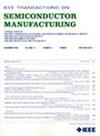用约束规划调度现实世界的光刻区域
IF 2.3
3区 工程技术
Q2 ENGINEERING, ELECTRICAL & ELECTRONIC
引用次数: 0
摘要
本文研究了某半导体制造工厂光刻车间的机器调度问题。该调度问题的特点是一个不相关的并行机器调度问题,包含机器的合格性、序列和机器相关的设置时间、辅助资源和辅助资源的传输时间。每个作业都需要两个辅助资源:一个十字线和一个吊舱。线是在pod中处理的,一个pod包含多个线。在多台机器上都使用了reticles和pods,如果从一台机器传输到另一台机器,则需要一定的传输时间。提出了一种新的约束规划(CP)方法,并以混合整数规划(MIP)方法为基准。该研究的结果由一家全球半导体制造商的实际案例研究组成,表明CP方法明显优于MIP方法,并为多个实际实例提供高质量的解决方案,尽管不能保证最优性。本文章由计算机程序翻译,如有差异,请以英文原文为准。
Scheduling a Real-World Photolithography Area With Constraint Programming
This paper studies the problem of scheduling machines in the photolithography area of a semiconductor manufacturing facility. The scheduling problem is characterized as an unrelated parallel machine scheduling problem with machine eligibilities, sequence- and machine-dependent setup times, auxiliary resources and transfer times for the auxiliary resources. Each job requires two auxiliary resources: a reticle and a pod. Reticles are handled in pods and a pod contains multiple reticles. Both reticles and pods are used on multiple machines and a transfer time is required if transferred from one machine to another. A novel constraint programming (CP) approach is proposed and is benchmarked against a mixed-integer programming (MIP) method. The results of the study, consisting of a real-world case study at a global semiconductor manufacturer, demonstrate that the CP approach significantly outperforms the MIP method and produces high-quality solutions for multiple real-world instances, although optimality cannot be guaranteed.
求助全文
通过发布文献求助,成功后即可免费获取论文全文。
去求助
来源期刊

IEEE Transactions on Semiconductor Manufacturing
工程技术-工程:电子与电气
CiteScore
5.20
自引率
11.10%
发文量
101
审稿时长
3.3 months
期刊介绍:
The IEEE Transactions on Semiconductor Manufacturing addresses the challenging problems of manufacturing complex microelectronic components, especially very large scale integrated circuits (VLSI). Manufacturing these products requires precision micropatterning, precise control of materials properties, ultraclean work environments, and complex interactions of chemical, physical, electrical and mechanical processes.
 求助内容:
求助内容: 应助结果提醒方式:
应助结果提醒方式:


